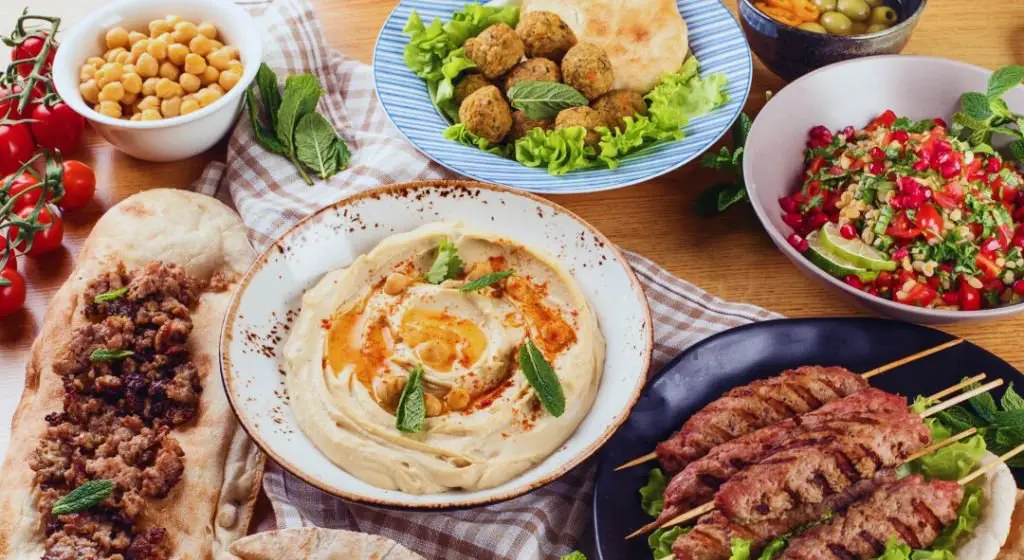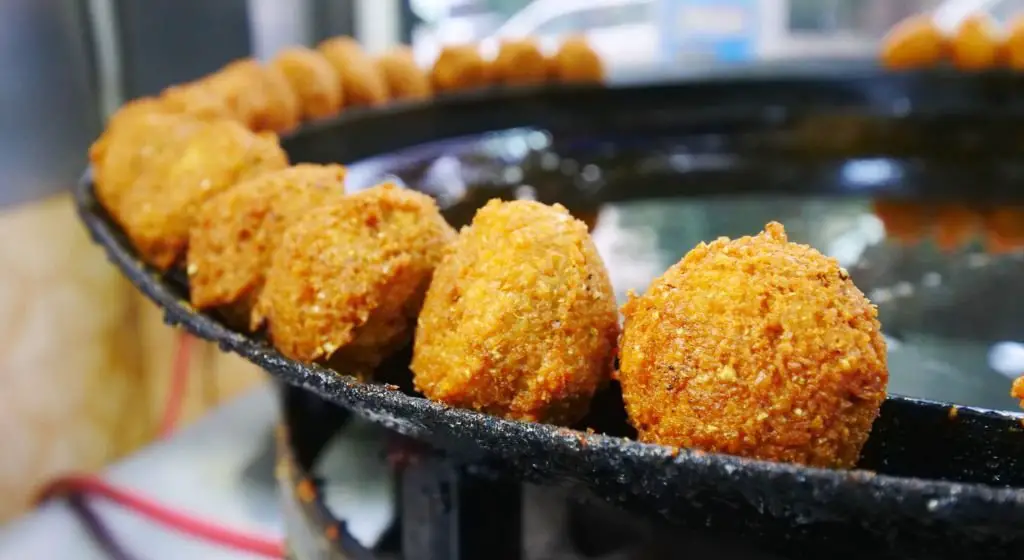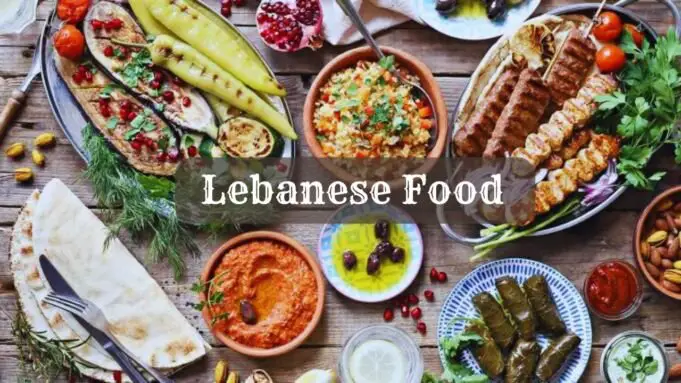Lebanese Food stands as a testament to the country’s rich history and the vibrant tapestry of cultures that have influenced this small yet significant Mediterranean nation. Rooted in ancient traditions, yet open to the influences of both the East and West, Lebanese food offers an enticing exploration of flavors, aromas, and culinary techniques that reflect the diversity and hospitality of its people.
Lebanese Food evokes various sensory experiences, from the aromatic, intense perfume of cinnamon, cumin, thyme, and roasting meat to the clear, refreshing notes of leafy green herbs, zesty lemon, and garlic. With vivid flashes of lemony sumac, earthy za’atar, and the flowery sweetness of desserts infused with golden honey, the rich meal is complete.
What Is Lebanese Food?
Lebanese cuisine refers to Lebanon’s rich culinary traditions, which are entrenched in Levantine flavors and methods. Though Lebanese recipes often include meat (typically chicken, lamb, and occasionally beef or fish), many dishes are vegan due to the country’s love of nutritious grains, legumes, and fresh vegetables. Many dishes revolve around the concept of mezze, a dining style that serves a whole meal on a spread of small plates.
Key Ingredients in Lebanese Cooking
At the heart of Lebanese cooking lies a bounty of fresh ingredients that encapsulate the essence of the Mediterranean diet. With its rich, fruity notes, olive oil forms the base of many dishes, complemented by the tang of fresh lemon juice, the zest of garlic, and a symphony of herbs and spices like mint, parsley, and allspice.
Fresh vegetables, legumes, and grains are the backbone of the diet, providing nutrition and variety to the Lebanese table.
How to Plan A Lebanese Sample Menu?
Planning a Lebanese sample menu involves curating a selection of dishes that encapsulate the vibrant and diverse flavors of Lebanese food. Start with an array of mezze such as Hummus, Tabbouleh, and Baba Ganoush, offering a taste of Lebanon’s rich appetizers. For the main course, consider serving a mix of grilled meats like Kafta and Shawarma alongside vegetarian options such as Falafel and Mujaddara, ensuring a balanced variety.
Complement these with side dishes of Fattoush or a refreshing Cucumber Yogurt Salad. Conclude the meal with a sweet note, featuring classic desserts like Baklava or Knafeh, paired with traditional Lebanese coffee or mint tea. This approach allows guests to experience the full spectrum of flavors and textures that Lebanese cuisine has to offer, making for an unforgettable dining experience.
Related: Turkish Foods
Traditional Lebanese Dishes
The Lebanese dining experience is incomplete without the iconic mezze, an assortment of small dishes that set the stage for a meal. Among these, Hummus, a smooth chickpea paste enriched with tahini and lemon, and Tabbouleh, a refreshing salad of parsley, tomatoes, and bulgur, stand out as beloved classics. Kibbeh, Lebanon’s national dish, showcases the art of mincing meat with bulgur and spices, often served raw or cooked in various forms.
Main courses often feature Shawarma, where spiced meat is roasted on a spit and served with garlic sauce in pita bread, and Mansaf, a communal dish of lamb and fermented yogurt, symbolizing the generosity of the Lebanese spirit.
Desserts like Baklava and Knafeh seduce the palate with their sweet, nutty flavors, wrapped in layers of pastry or semolina, drenched in syrup.
25 Most Popular Lebanese Dishes

A gastronomic journey through the heart of the Middle East with our exploration of the 25 most popular Lebanese dishes. Lebanese cuisine, a treasure trove of flavors and traditions, is renowned for its diversity, blending the richness of herbs and spices with the freshness of its ingredients.
From the tangy zest of Tabbouleh to the sweet layers of Baklava, each dish offers a unique taste that tells a story of Lebanon’s cultural heritage. Whether you’re a seasoned foodie or new to Lebanese flavors, these dishes promise an unforgettable culinary adventure, inviting you to savor the essence of Lebanon’s generous and vibrant food culture.
Hummus
Hummus is a creamy dip made from blended chickpeas, tahini, lemon juice, and garlic. This versatile dish serves as a staple in Lebanese mezze and is enjoyed worldwide for its savory flavor and health benefits. It can be garnished with olive oil, paprika, and parsley, making it a delightful spread or dip.
Tabbouleh
Tabbouleh is a refreshing parsley salad, finely chopped and mixed with bulgur wheat, tomatoes, mint, onion, lemon juice, and olive oil. This vibrant dish is celebrated for its fresh, zesty flavors and is a quintessential component of Lebanese mezze.
Kibbeh
Kibbeh, often considered Lebanon’s national dish, involves a mixture of finely ground meat (usually lamb or beef), bulgur, onions, and spices. It can be served raw, baked, fried, or cooked in broth, showcasing its versatility and rich flavors.
Falafel
Falafel consists of deep-fried balls or patties made from ground chickpeas or fava beans, mixed with herbs and spices. These crispy delights are commonly served in pita bread with vegetables and tahini sauce, offering a beloved vegetarian option.
Read More: Best Restaurants in Gatlinburg for Every Food Lover
Shawarma
Shawarma features thinly sliced marinated meat, such as chicken, beef, or lamb, slow-roasted on a rotating spit. Served in a wrap or sandwich with garlic sauce, pickles, and fries, it’s a favorite for its savory and slightly tangy taste.
Fattoush
Fattoush is a Lebanese bread salad made with mixed greens, fresh vegetables, and crispy pieces of pita bread, dressed with olive oil, lemon juice, and sumac. It’s cherished for its crunchy texture and tangy flavor.
Manakish
Manakish, similar to a flatbread pizza, is topped with za’atar, cheese, or ground meat. Baked in a wood-fired oven, it’s a popular breakfast or snack, offering a warm, aromatic treat.
Labneh
Labneh is strained yogurt that achieves a thick, creamy consistency, often served as a dip or spread. It can be flavored with herbs and drizzled with olive oil, embodying the simplicity and richness of Lebanese cuisine.
Mujaddara
Mujaddara is a comforting dish made from cooked lentils and rice, caramelized onions, and seasoned with cumin. It’s a hearty vegetarian option, revered for its satisfying flavors and nutritional value.
Sfiha
Sfiha, also known as Lebanese meat pies, features dough topped with a mixture of minced meat, tomatoes, onions, and pine nuts, baked until golden. These savory pastries are perfect as appetizers or snacks.
Batata Harra
Batata Harra is a spicy dish of cubed potatoes, sautéed with garlic, coriander, chili, and sometimes sweet peppers. It’s a flavorful side dish, known for its fiery kick and crispy texture.
Sayadieh
Sayadieh combines seasoned fish with a fragrant bed of rice and caramelized onions, often accompanied by a tangy sauce. This seafood dish is praised for its layers of flavor and comforting qualities.
Kafta
Kafta involves skewered and grilled ground meat, mixed with parsley, onions, and Lebanese spices. It’s a barbecue favorite, offering juicy, flavorful bites that pair well with a variety of sides.
Makanek
Makanek are small Lebanese sausages, typically made from lamb or beef and flavored with spices like cinnamon, nutmeg, and garlic. Fried or grilled, they’re a tantalizing mezze dish.
Samkeh Harra
Samkeh Harra is a spicy fish dish, traditionally made with a whole fish that’s baked or grilled, then topped with a hot tahini-based sauce. It’s a testament to the Lebanese love for bold flavors and seafood.
READ: Nigerian Food
Kousa Mahshi
Kousa Mahshi involves hollowed-out zucchinis stuffed with a mix of meat, rice, and spices, then cooked in tomato sauce. This dish highlights the Lebanese flair for stuffing and slow-cooking vegetables.
Warak Enab
Warak Enab, or stuffed grape leaves, are filled with a mixture of rice, tomatoes, parsley, and mint, seasoned with lemon juice and olive oil. They can be served cold as a mezze or hot as a main dish.
Rkakat
Rkakat are crispy, cigar-shaped pastries filled with cheese or minced meat. Fried or baked until golden, they’re a crowd-pleasing appetizer, offering a delightful crunch with every bite.
Arayes
Arayes consists of pita bread stuffed with seasoned ground meat, then grilled until crispy. It’s a simple yet flavorful dish, perfect for sharing and snacking.
Lahm bi Ajeen
Lahm bi Ajeen, Lebanese meat pies, feature a thin crust topped with a spiced mixture of minced meat, tomatoes, and onions. Baked to perfection, they offer a savory and satisfying experience.
Loubieh bi Zeit
Loubieh bi Zeit, a vegan staple, combines green beans cooked in olive oil with tomatoes, onions, and garlic. It’s a light yet flavorful dish, showcasing the beauty of Lebanese vegetable cooking.
Shish Barak
Shish Barak includes small meat dumplings cooked in a yogurt-based stew, flavored with garlic and mint. This comforting dish is a delightful blend of textures and tangy flavors.
Ras Asfour
Ras Asfour, translating to “sparrow’s head,” features small pieces of meat (often lamb or beef) cooked in a pomegranate molasses sauce. It’s a sweet and sour dish, enjoyed for its tender bites and rich sauce.
Halawet El Jibn
Halawet El Jibn is a sweet cheese dessert, rolled and stuffed with cream and drizzled with syrup, often garnished with pistachios. It’s a luxurious treat, blending the flavors of cheese and sweet syrup.
Baklava
Baklava, a famous Lebanese dessert, consists of layers of filo pastry, filled with nuts and soaked in honey or syrup. It’s a sweet, crunchy delight, celebrated in Lebanese cuisine and beyond.
Knafeh
Knafeh combines a layer of stretchy cheese with semolina or shredded wheat pastry, soaked in sweet syrup. This cheesy, syrupy dessert is a favorite in Lebanon, offering a unique taste and texture.
READ: How Many People Visit Fast Food Restaurants?
Lebanese Street Food

The streets of Lebanon are a paradise for food lovers, offering delights such as Falafel, deep-fried chickpea balls tucked into fluffy pitas with veggies and tahini, and Manakish, a pizza-like creation topped with za’atar or cheese.
Lebanese Beverages
Lebanese coffee, strong and aromatic, is a staple, often accompanied by Arak, a traditional anise-flavored spirit, showcasing the Lebanese love for meals that turn into social gatherings.
Dining Etiquette in Lebanon
Lebanese meals are a communal affair, emphasizing sharing and hospitality. Dining etiquette in Lebanon reflects the country’s warm and inclusive culture, where meals are not just about eating but about coming together.
Lebanese Food Beyond Borders
The global spread of Lebanese cuisine speaks to its universal appeal. Around the world, Lebanese restaurants serve up a taste of Lebanon, adapting traditional dishes to local tastes while staying true to the essence of Lebanese cooking.
Read Also: AirFood Recipes
Tips for Cooking Lebanese Food
The essence of Lebanese food lies in its use of vibrant, fresh ingredients. Opt for seasonal fruits and vegetables, preferably from your local farmers’ market, to ensure top-notch quality.
- Create your blend of spices. Crafting your own spice mixes allows you to tailor flavors to your preference, making it simple to adjust the spice levels or herbal notes in your dishes.
- Check the freshness of your spices. Dried spices lose their potency over time. To test them, crush a bit between your fingers; they should emit a strong fragrance. If not, it’s time for a replacement.
- Dare to explore. Venturing into new culinary territories might seem intimidating, but trying traditional Lebanese recipes can be incredibly rewarding. I only share dishes I love, encouraging you to broaden your culinary horizons and find new favorites.
- Incorporate nuts. Lebanese recipes often feature nuts like almonds and pine nuts, with Hashweh as a prime example, where pine nuts add a buttery depth to the beef. Pistachios and walnuts are also staple nuts in Lebanese desserts, offering distinct flavors.
- Prepare your pantry. Having key ingredients ready makes Lebanese cooking a breeze. Essentials include bulgur, lentils, chickpeas, and olive oil for the pantry, with yogurt, beef, and lamb for the fridge. Staples like cucumber, tomato, onion, and eggplant should always be at hand for fresh produce.
Conclusion
Lebanese cuisine is more than just a collection of dishes; it’s a celebration of Lebanon’s history, land, and people. It invites everyone to gather around the table, share a meal, and experience the warmth and richness of Lebanese culture. So, embark on this culinary journey and let the flavors of Lebanon transport you to a world where food is a feast for the senses and a bridge between cultures.
Read Also: French Foodie in Dublin Irish Food Blog Tours and Events
Frequently Asked Questions (FAQs) about Lebanese Food
Here you can find a few commonly asked questions about Lebanese cuisine. Let’s check them out.
What are the key characteristics of Lebanese cuisine?
Lebanese cuisine is known for its diverse array of flavors, fresh ingredients, and emphasis on fruits, vegetables, whole grains, and lean proteins. It features a significant use of herbs, garlic, lemon, and olive oil, creating dishes that are both flavorful and healthy.
What is a typical Lebanese meal?
A typical Lebanese meal often starts with mezze, and small appetizer plates like Hummus, Tabbouleh, and Baba Ganoush. This is followed by a main dish, possibly grilled meats or a stew, accompanied by rice or bread. Meals often conclude with a sweet dessert such as Baklava.
Are there vegetarian options in Lebanese cuisine?
Yes, Lebanese cuisine offers a wealth of vegetarian options. Dishes like Falafel, Mujaddara (lentils and rice), and various mezze items provide ample choices for vegetarians.
How important is bread in Lebanese food?
Bread is a staple in Lebanese cuisine, with pita bread being the most common. It is used as a utensil for scooping up food or sauces and is integral to dishes like Shawarma and Falafel wraps.
What are some traditional Lebanese desserts?
Traditional Lebanese desserts include Baklava (a sweet pastry made of layers of filo filled with nuts and sweetened with syrup or honey), Knafeh (a cheese pastry soaked in sweet syrup), and Maamoul (shortbread pastries filled with dates, nuts, or figs).
Is Lebanese food healthy?
Lebanese food is considered quite healthy due to its heavy reliance on whole foods, lean proteins, and a wide variety of fresh vegetables and fruits. Olive oil, a heart-healthy fat, is also a mainstay in Lebanese cooking.
Can I make Lebanese dishes at home if I’m not familiar with the cuisine?
Many Lebanese dishes are straightforward and require ingredients that are accessible in most grocery stores. With a good recipe, anyone can prepare delicious Lebanese meals at home, from savory mezze to hearty main courses and sweet desserts.





![25 Best Peruvian Foods You Must Try In Peru [With Recipes] Peruvian Food](https://tourinplanet.com/wp-content/uploads/2024/07/Peruvian-Food-238x178.jpg)




![What Does Aviates Stand for in Aviation? [The Art of Flying] Aviates](https://tourinplanet.com/wp-content/uploads/2024/07/Aviates-100x75.jpg)














![25 Best Peruvian Foods You Must Try In Peru [With Recipes] Peruvian Food](https://tourinplanet.com/wp-content/uploads/2024/07/Peruvian-Food-100x75.jpg)


